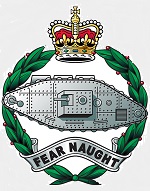Hobby Master HG3502 British Centurion Mk.5 Main Battle Tank - "Diehard", 10 Troop, A Squadron, 4th Royal Tank Regiment, West Berlin, August 22nd, 1961 (1:72 Scale)
"From Stettin in the Baltic to Trieste in the Adriatic, an iron curtain has descended across the Continent. Behind that line lie all the capitals of the ancient states of Central and Eastern Europe. Warsaw, Berlin, Prague, Vienna, Budapest, Belgrade, Bucharest and Sofia, all these famous cities and the populations around them lie in what I must call the Soviet sphere, and all are subject in one form or another, not only to Soviet influence but to a very high and, in many cases, increasing measure of control from Moscow."
- Excerpted from British Prime Minister Winston Churchill's "Sinews of Peace" speech delivered at Westminster College, in Fulton, Missouri, March 5th, 1946
 The Centurion was Britain's first attempt to produce a universal tank and do away with divisions between the infantry tanks, such as the Matilda, and cruiser tanks like the Comet. In 1943, after a succession of unfortunate tank designs, the British War Office commissioned a new specification calling for a tank weighing 40-tons that offered durability, reliability, and the ability to withstand a direct hit from a German 88mm gun. Six prototypes were developed before the end of World War II, all of which arrived too late to take part in the war.
The Centurion was Britain's first attempt to produce a universal tank and do away with divisions between the infantry tanks, such as the Matilda, and cruiser tanks like the Comet. In 1943, after a succession of unfortunate tank designs, the British War Office commissioned a new specification calling for a tank weighing 40-tons that offered durability, reliability, and the ability to withstand a direct hit from a German 88mm gun. Six prototypes were developed before the end of World War II, all of which arrived too late to take part in the war.
It was soon recognized that the weight restrictions had to be lifted as the original specification could not be achieved within the 40-ton weight limitation. The early vehicles were equipped with a 17 pounder main gun and a 20mm Polsten cannon. They also featured frontal, glacis plate armour to deflect shots, a partially cast turret and a Horstmann suspension. However, modifications to the original design were quickly made and the changes resulted in the adoption of a 20 pounder, fully stabilized main gun and the replacement of the 20mm cannon with a Besa machine gun (thus allowing the turret to be fully cast). These changes resulted in the Mk IV version of the vehicle.
In order to maintain its combat effectiveness, continuing modifications have led to numerous other changes to the main gun armament (most notably the incorporation of a 105mm gun), the addition of fire control equipment and infra-red driving aids, a new diesel engine, and a semi-automatic transmission.
The Centurion first saw action in Korea during 1951 and soon proved itself to be the best performing tank in this theatre of operations, offering excellent cross country performance. It has also been exported to a number of client nations, particularly Israel, which used them with great effect in several of the Arab-Israeli Wars.
Pictured here is a 1:72 scale replica of a British Centurion Mk.5 Main Battle Tank that served with 10 Troop, A Squadron, 4th Royal Tank Regiment, then deployed to West Berlin, during August 22nd, 1961.
Sold Out!
Dimensions:
Length: 4-inches
Width: 1-1/2-inches
Release Date: June 2008
Historical Account: "Watch on the Rhine" - There have been two formations named British Army of the Rhine (BAOR). Both were originally occupation forces in Germany, one after World War I, and the other after WWII.
The second British Army of the Rhine was formed on August 25th, 1945 from 21st Army Group. Its original function was to control the corps districts which were running the military government of the British zone of occupied Germany. After the assumption of government by civilians, it became the command formation for the troops in Germany only, rather than being responsible for administration as well.
As the Soviet threat increased, BAOR became more responsible for the defense of Germany than its occupation. It became the primary formation controlling the British contribution to NATO after the formation of the alliance in 1949. Its primary combat formation was the British I Corps. From 1952 onwards, the commander-in-chief of the BAOR was also the commander of NATO's Northern Army Group (NORTHAG) in the event of a general war with the Soviet Union and the Warsaw Pact.
The 1993 Options for Change defense cuts resulted in BAOR being replaced by the 25,000 strong British Forces Germany (BFG) in 1994. (courtesy: Wikipedia)





![Star Trek Bajoran Raider [With Collector Magazine]](http://cdn4.volusion.store/qh9e9-jdqv9/v/vspfiles/photos/EMST0074-1.jpg?v-cache=1740197136)
